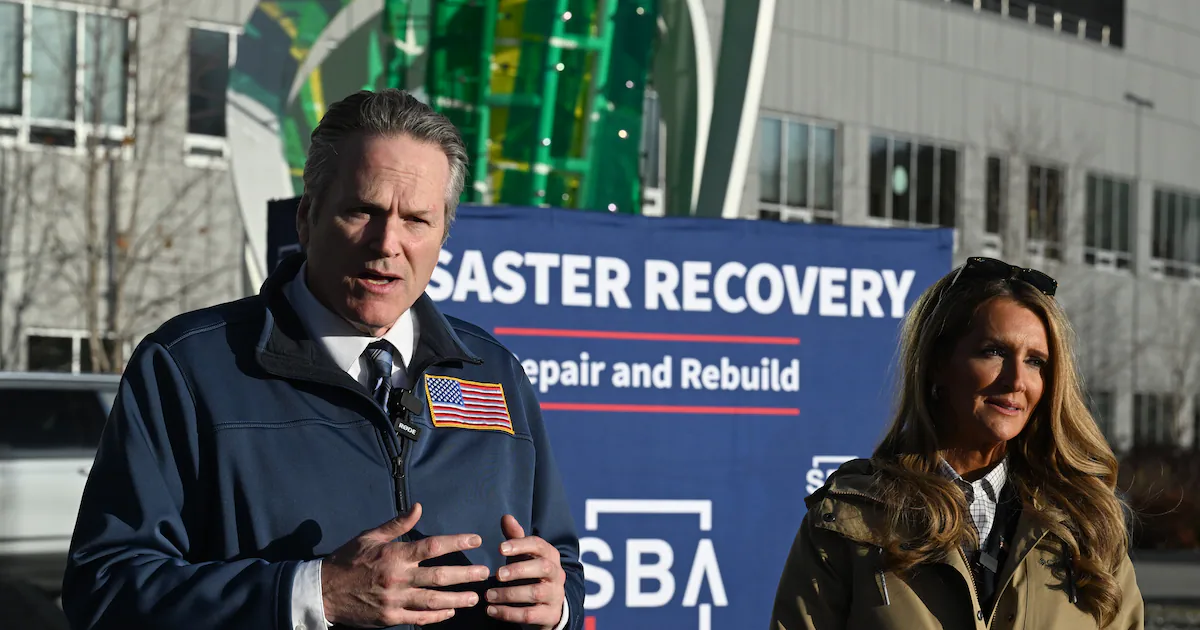Copyright Anchorage Daily News

As officials work to move displaced Western Alaska residents to longer-term housing, Gov. Mike Dunleavy says he’ll focus on “recovery and relief” efforts before turning to thornier questions about the long-term future of two communities devastated by a disastrous storm earlier this month. Dunleavy and Kelly Loeffler, administrator of the U.S. Small Business Administration, met Wednesday with Yukon-Kuskokwim Delta residents displaced earlier this month by ex-Typhoon Halong who have been sheltering at the Alaska Airlines Center in Anchorage for the last two weeks. Loeffler said the federal agency is making low-interest loans available to residents who suffered damage. Officials this week began moving hundreds of evacuees from congregate shelter spaces in Anchorage into longer-term housing such as apartments and hotels, while others raced to help winterize communities and conduct basic repairs in villages so displaced residents can start returning home. Extensive damage in Kwigillingok and Kipnuk has prompted discussion about whether those communities should be rebuilt or moved to areas that provide better protection from tidal surge flooding brought by powerful storms like Halong. The storm destroyed 90% of Kipnuk’s structures and leveled or displaced about 40% of the houses in Kwigillingok, according to the State Emergency Operations Center. After meeting with evacuees on Wednesday, Dunleavy said his priority was making ravaged villages livable so displaced residents could return, hopefully before more severe winter weather sets in. While Kipnuk is “in rough shape,” with Kwigillingok “right there as well,” he said he believed that people would be surprised at the “extent we’re able to get things going.” “On the question of relocation, that’s gonna be a discussion that’s going to probably unfurl this winter, this spring and may take some time to really get a resolution to,” Dunleavy said. With the number of communities situated at or near sea level and an apparent increase in the number of severe storms that cause flooding, Dunleavy acknowledged that “we have to have that discussion” about how to protect vulnerable communities, how to pay for those measures, and whether it was more reasonable to relocate communities to higher ground. Answering those questions will be a long and complicated process that would have to consider the needs or wants of affected community members, he said. “These discussions don’t happen every day, moving entire villages or how do you make it more resilient to these types of floods.” More than 650 people evacuated to Anchorage in the wake of the storm. On Monday, 18 families consisting of 108 evacuees were moved from shelters at the Alaska Airlines Center or Egan Civic and Convention Center downtown to hotels, according to a Tuesday situation report from the State Emergency Operations Center. Twenty families, or just over 90 people, moved to non-congregate housing Tuesday as “demobilization” of the arena as a shelter began, according to a report Wednesday. The state had received more than 1,120 applications for individual state assistance as of Wednesday afternoon, according to emergency officials. Loeffler said Wednesday that the federal Small Business Administration had opened up a number of low-interest recovery loans to businesses, nonprofit organizations and residents affected by the storm in addition to an initial $25 million in federal aid pledged by President Donald Trump on Oct. 22. Total recovery costs, Loeffler said, will probably amount to “much, much more.” She said the SBA has changed its lending rules to better accommodate the “unique” needs of Alaska villages such as losses at subsistence camps. For example, home and personal property loans can be taken out to cover damage to subsistence gathering equipment and camp property, like boats and snowmachines, the SBA said in a statement Monday. “We’re going to continue to respond to the unique needs of the terrain, of the people, of this culture and make sure that the funding meets the moment,” Loeffler said Wednesday. Other forms of aid have also started to filter to those who need it. On Wednesday, the Alaska Community Foundation said a relief fund established to help support cleanup and recovery efforts in the Yukon-Kuskokwim region and others affected by Halong and a previous powerful storm had raised more than $2.9 million since Oct. 12. Some of that money, $575,000, had already been given to organizations involved in the disaster response effort, the foundation said in a statement Wednesday. Foundation President and CEO Alexandra McKay said in a statement that she was thankful for the faith that tribal and regional partners placed in the foundation to “direct resources where they’re needed most— whether that’s emergency supplies, evacuation support, or beginning the long work of recovery and rebuilding."



